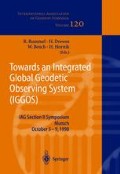Abstract
The fluctuation of the angular positions of reference extra galactic radio sources caused by the gravitational lensing on visible stars and dark bodies of our Galaxy is considered. It is shown that these angular fluctuations range from a few up to hundreds of microarcseconds. The random proper motions of the stars and the dark bodies lead to a small rotation of the celestial reference frame. It limits the accuracy of realization of the inertial reference frame. It is shown that the gravitational lensing does not allow to align the axes of the different reference frames better than a few microarcseconds.
Access this chapter
Tax calculation will be finalised at checkout
Purchases are for personal use only
Preview
Unable to display preview. Download preview PDF.
References
Arias E.F., Charlot P., Feissel M., Lestrade J.-F. (1995). The exrtagalactic reference system of the International Earth Rotation Sernice, ICRS. Astronomy and Astrophysics, Vol.303, pp.604–608.
ESA. (1997). The Hipparcos and Tycho Catalogues. ESA Publication SP-1200.
IERS. (1996). 1995 IERS Annual report. Observatoire de Paris, Paris.
Kovalevsky J. (1998). The new astrometry. Reports of Progress Physics, Vol. 61, pp.77–115.
Lasker B.M., Struch C.R., Mclean B.J., Russel J.L., Jenkner H., Shara M.M. (1990) The Guide Star Catalogue. 1. Astronomical foundations and image processing. The Astronomical Journal, Vol. 99, pp.2019.
Ma C., Arias E.F., Eubanks T.M., Fey A.L. et al. (1998). The international Celestial Reference Frame as realized by Very Long Baseline Interferometry. The Astronomical Journal, Vol.116, pp.516–546.
Sazhinm V., Zharov V.E., Volynkin A.V., Kalinina T.A. (1998) Microarcseconds instability of the celestial reference frame. MNRAS, Vol.300, pp.287–301.
Author information
Authors and Affiliations
Editor information
Editors and Affiliations
Rights and permissions
Copyright information
© 2000 Springer-Verlag Berlin · Heidelberg
About this paper
Cite this paper
Zharov, V.E., Sazhin, M.V., Kalinina, T.A. (2000). Weak Gravitational Lensing and Instability of the Celestial Reference Frame. In: Rummel, R., Drewes, H., Bosch, W., Hornik, H. (eds) Towards an Integrated Global Geodetic Observing System (IGGOS). International Association of Geodesy Symposia, vol 120. Springer, Berlin, Heidelberg. https://doi.org/10.1007/978-3-642-59745-9_22
Download citation
DOI: https://doi.org/10.1007/978-3-642-59745-9_22
Publisher Name: Springer, Berlin, Heidelberg
Print ISBN: 978-3-642-64107-7
Online ISBN: 978-3-642-59745-9
eBook Packages: Springer Book Archive

